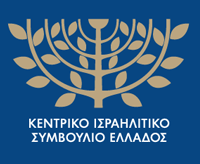ISRAELI COMMUNITY OF VOLOS
.jpg) Ancient historical texts state that from 1ο century AD Jews lived in the region of Magnesia and specifically in neighboring Almyros.
Ancient historical texts state that from 1ο century AD Jews lived in the region of Magnesia and specifically in neighboring Almyros.
In ancient Dimitriada (today's Volos), historians testify that Jews lived from 2ο century AD But also in the neighboring city "Fthiotides Thebes or Achaikes" (today N. Aghialos), ancient Jewish tombstones from the period 325-641 AD were discovered.
12ο century the Spanish traveler Rabbi Benjamin ben Jonah, from Tudela, wrote in his "journey" that "in Almyros there was a flourishing Community of 400 Jews headed by Chief Rabbi Shiloh Lombardo and Rabbis Joseph and Solomon".
The presence of Jews in Volos continued during the Turkish rule and diplomatic documents of the 16th century, refer to them. When in 1881 the city was freed from the Turkish yoke (2.11.1881) there was an organized Jewish Community, as evidenced by newspaper reports of the time. The Community has since then continued its strong presence in the commercial, social and spiritual life of Volos.
 The first Synagogue it was built in 1870 in the center of the Jewish quarter, replacing an earlier crude wooden structure. This beautiful Synagogue was blown up by the Germans in March 1943. In its place, a Synagogue was built in 1948, but it was destroyed by the earthquakes in 1955.
The first Synagogue it was built in 1870 in the center of the Jewish quarter, replacing an earlier crude wooden structure. This beautiful Synagogue was blown up by the Germans in March 1943. In its place, a Synagogue was built in 1948, but it was destroyed by the earthquakes in 1955.
In 1960, another smaller, anti-seismic one was built in the same place, which is still in operation today. It is located at the junction of Xenophontos – Platonos – Moiseos streets.
The first Jewish cemetery it was located in the "Neapolis" district (Filikis Etairias street). The newest one, which is still in use today, is located next to the Christian one, at the intersection of Taxiarchon - Platonos streets. It has an area of 4.000 sq.m. and includes 700 tombs.
From 1865, the first branch of the French school Alliance Israelite Universelle operated in the community and later the primary school of the community (1870-1926). A small seminary was also established in 1894.
From the first decade of the 1900s, various charitable and other Community Associations were founded, such as "ABAATH REIM" (1901) which was succeeded - in 1921 - by the "Agudad Achim" Mutual Aid Association. In 1910 the Zionist Association "Poale Zion" was established and later the Sisterhood of Ladies "Ozer Dalim". Also, the youth sports team "Atikva" which was succeeded by "Akoah", as well as the scout team "Maccabi" (1933). At the same time, there were the committees "Bikur Holim", "Hevra Kendusa" etc.

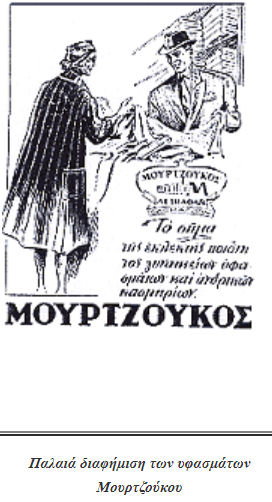 The activity of the Jews of Volos was intense in the professional and economic development of Volos, with many commercial and craft shops as well as industries that employed a large number of workers. The large "Mourtzoukou" textile industry, the Levi Brothers spinning mill, the Amon & Azuz factory, the Isaac Saporta tobacco warehouses, the Baruch-Levi Bank and other businesses that dominated the city are noted.
The activity of the Jews of Volos was intense in the professional and economic development of Volos, with many commercial and craft shops as well as industries that employed a large number of workers. The large "Mourtzoukou" textile industry, the Levi Brothers spinning mill, the Amon & Azuz factory, the Isaac Saporta tobacco warehouses, the Baruch-Levi Bank and other businesses that dominated the city are noted.
There was also a great contribution of the Jews of Bolio in the establishment of Noble Institutions, cultural and sports Clubs and professional bodies in the administrations of which they participated, as well as in the Municipal affairs of the city.
The Municipality of Volos, in order to honor the local Jewishness, gave names to streets in the city such as "Mouseos" (1892), "Palastinis" (1922), "Abraham Benaroya" (1984) and "Chief Rabbi Moses Pesach" (1993).
The Community in 1920 numbered about 2.000 members. Gradually, however, their number began to decrease by settling in other cities or emigrating. In 1940 there were 872 members.
WORLD WAR II
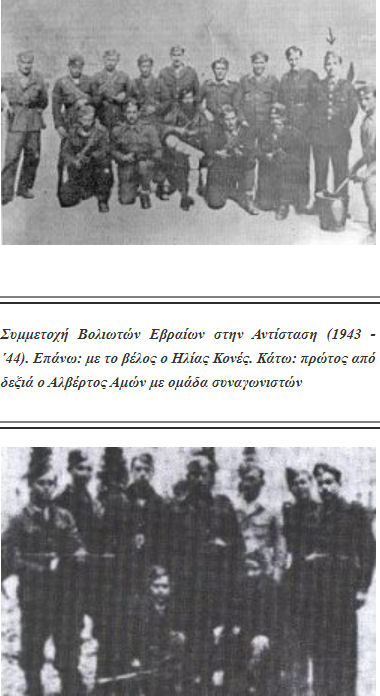 During the period of the Greek-Italian war (1940) 71 Jews were recruited to fight at the front. Of these, one was killed, five were wounded and 2 were disabled during the fighting. At the front, the community's contribution was universal throughout the war effort.
During the period of the Greek-Italian war (1940) 71 Jews were recruited to fight at the front. Of these, one was killed, five were wounded and 2 were disabled during the fighting. At the front, the community's contribution was universal throughout the war effort.
In April 1941 the city was occupied by Italian troops, but the Jews faced no immediate danger. In September 1943, when Italy capitulated to the Allies, Volos was occupied by the Germans. During the occupation, many Jews, especially young people, participated in the National Resistance, offering great services. The first anti-Jewish measures of the Germans took place in October 1943. Then most of the Jews, with the help of the Church, the National Resistance, the State and fellow citizens, were able to escape to the surrounding villages where they were rescued.
During the liquidation operations of the Germans, in March 1944, 155 members of the Community were arrested, who were sent to Hitler's camps where they were exterminated.
LIBERATION AND REORGANIZATION OF THE COMMUNITY
With the liberation of the city, in October 1944, the Central Israeli Council and Charitable Organizations abroad (AJDC) contributed in every way to the reorganization of the Community. The earthquakes in Volos (1955) caused great damage to houses, shops and community buildings. But there was immediate and effective help both from the state and from Jewish Organizations for the rehabilitation of those affected.
From 1948 immigration intensified to Israel and later to the USA. Today the Community consists of 100 people who continue their harmonious coexistence with fellow Christians.
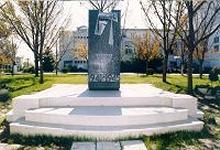
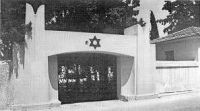 The Community is governed by a five-member Board of Directors which is elected by the fourteen-member Community Assembly every three years. The Council focuses on caring for the needy, educating children while subsidizing youth programs. He attaches particular importance to the operation of the Synagogue, to the strengthening of the relations between the members, fellow citizens and the local authorities, which are maintained to this day excellent.
The Community is governed by a five-member Board of Directors which is elected by the fourteen-member Community Assembly every three years. The Council focuses on caring for the needy, educating children while subsidizing youth programs. He attaches particular importance to the operation of the Synagogue, to the strengthening of the relations between the members, fellow citizens and the local authorities, which are maintained to this day excellent.
The Synagogue lit performs normally on all Jewish holidays, while weddings, Bar and Bat Mitzvahs, memorial services and Holocaust Remembrance events are held there.
In 1988, the Municipality of Volos, appreciating the contribution of the Jews to the city and honoring the victims of the Nazi persecution, erected a Memorial for the victims of the Holocaust in the central square of Riga Ferrai.
Today the Community, despite its small human resources, continues its historical path with vitality and activity.
